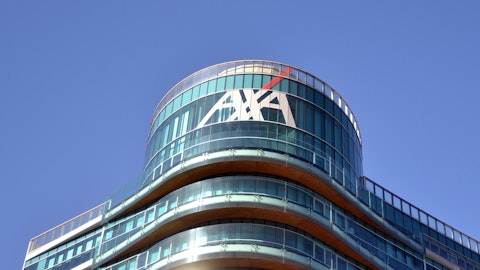In this article, we will take a look at 16 of the biggest banks in the world. If you want to see more of the biggest banks in the world, go directly to 5 Biggest Banks in the World.
The biggest banks in the world, otherwise known as megabanks, are giant companies that have substantial assets on their balance sheets. Many offer a variety of different financial services including commercial banking, corporate banking, capital markets, asset management, and more.
Given their scale, many megabanks enjoy substantial advantages versus smaller banks, especially in technology. Bloomberg’s Paul J. Davies writes, “The biggest banks, with the greatest profits, are already investing vastly more in faster, cheaper, easier-to-use digital apps than smaller banks can afford. Technology is helping big banks gain market share and is more likely to drive consolidation in the years ahead than regional bank mergers.”
In 2022 alone, JPMorgan Chase & Co. (NYSE:JPM)’s budget for technology in its consumer and small business banking businesses was $2.8 billion, which is more than the revenue of many banks. With having greater technology in addition to other advantages, JPMorgan Chase & Co. (NYSE:JPM) has increased its market share in U.S. consumer deposits from 8.9% in 2017 to 10.3% in 2021 and CEO Jamie Dimon believes there could be even more growth in the future.
Davies adds, “Banking is increasingly a scale game where the biggest players are most able to absorb high fixed costs and generate the best returns. Advantage begets advantage as profits can be plowed back into making services cheaper and continuing to build smarter technology that customers want to use.”
The Leading Megabanks
Many of the world’s biggest banks are based in the United States or China.
Many megabanks are based in the United States because the United States has the world’s largest economy. In 2021, the U.S. had a GDP of $23 trillion, outpacing second place China’s $17.73 trillion and third place Japan’s $4.94 trillion.
In addition to having the world’s largest economy, the United States has the most popular global reserve currency with the U.S. dollar. According to the IMF, the U.S. dollar accounted for 59% of global foreign exchange reserves in 2021, versus 21% for the Euro, 6% for the Yen and 5% for the Great Britain Pound. Given the dominance, the U.S. enjoys lower interest rates than if the U.S. dollar wasn’t the dominant global reserve currency.
Several Chinese banks are among the biggest banks in the world. Given that China’s government plays a big role in the economy, it has played a part in the formation and growth of several megabanks there that help develop the country. With the big four banks in China each state owned, China’s government can sometimes use the Chinese megabanks for economic policies. It can sometimes be more efficient to ask big banks in China to make more loans than it is to simply lower the interest rate, for example.
Several Japanese banks also rank among the 16 Biggest Banks in the World given the size of Japan’s economy.
In terms of the future, there could eventually be several Indian companies that make it to the list given how quickly India’s economy is growing.
2022
Given high inflation, the Federal Reserve has increased interest rates multiple times this year.
With the substantially higher rates, there is a potential for an economic slowdown or a recession by the end of 2023 if not sooner. As a result, many megabanks, along with many other companies, could face headwinds.
Given the uncertainty, it could be a good idea for long term investors to own well diversified portfolio of stocks across many different sectors.

Pixabay/Public Domain
Methodology
For our list, we took the top 16 out from S&P Global Market Intelligence’s World’s 100 Largest Banks whose list is as of December 31, 2021 for the majority of banks on the list.
16 Biggest Banks in the World
16. Wells Fargo & Company (NYSE:WFC)
Total Assets: $1.95 trillion
Although rising interest rates could increase credit losses during an economic downturn, Wells Fargo & Company (NYSE:WFC) is currently benefiting from the rising rates with higher net interest income. Due to the interest rate increases, Wells Fargo & Company (NYSE:WFC) reported its best net interest income since 2019 and the bank estimates its net interest income will rise 24% year over year for 2022. If it is more profitable and the bank makes quality loans, Wells Fargo & Company (NYSE:WFC) could potentially realize a higher return on its assets.
15. Mizuho Financial Group
Total Assets: $1.96 trillion
Mizuho Financial Group is a Japan based bank holding company with $1.96 trillion in assets. The bank has a long history given it was founded in 1864 and Mizuho Financial Group is economically important given its commercial and retail banking operations. Mizuho Financial Group has over 20 million customers, representing approximately one fifth of the adult population in Japan.
14. Postal Savings Bank of China
Total Assets: $1.98 trillion
Postal Savings Bank of China is one of the largest banks in China with total assets of $1.98 trillion. Postal Savings Bank of China also has around 40,000 outlets, and offers services to more than 600 million personal customers. Given the slowing Chinese economy, Postal Savings Bank of China faces headwinds in the near term but the bank nevertheless has potential to increase its assets if it maintains its market share.
13. Japan Post Bank
Total Assets: $2 trillion
Japan Post Bank is a leading Japanese bank with $2 trillion in assets. Although the Japanese government owned around 57% of Japan Post Bank in 2020, it has a goal of divesting more of its stake in the future. If Japan Post Bank is a privately owned bank, it could potentially be more efficient.
12. Sumitomo Mitsui Financial Grp, Inc. (NYSE:SMFG)
Total Assets: $2.18 trillion
Sumitomo Mitsui Financial Grp, Inc. (NYSE:SMFG) is one of Japan’s largest banks with $2.18 trillion in total assets. Sumitomo Mitsui Financial Grp, Inc. (NYSE:SMFG) provides commercial banking, leasing securities, consumer finance and other services in Japan and internationally. Due to macroeconomic headwinds, Sumitomo Mitsui Financial Grp, Inc. (NYSE:SMFG) shares are down 16.8% year to date.
11. Citigroup Inc. (NYSE:C)
Total Assets: $2.29 trillion
Given Citigroup Inc. (NYSE:C) doesn’t have as big of a retail banking business as some of its other big four bank peers, the company hasn’t benefited that much from the higher rates. Like the other big banks in the United States, Citigroup Inc. (NYSE:C) faces headwinds if a recession occurs in 2023. In the long term, however, Citigroup Inc. (NYSE:C) still has substantial quality earnings potential and the bank ranks as one of the largest in the world by assets.
10. Crédit Agricole Group
Total Assets: $2.67 trillion
Crédit Agricole Group is France’s second largest bank with total assets of $2.67 trillion. Given its scale, Crédit Agricole Group has around 147,000 employees, 53 million customers, and operations in 47 countries. Like other international banks, Crédit Agricole Group faces near term headwinds given the economic slowdown globally.
9. BNP Paribas
Total Assets: $2.91 trillion
BNP Paribas is one of the largest banks in the world with $2.91 trillion in total assets. The France-based bank also has around 190,000 employees and operations in 65 countries. Although BNP Paribas sold Bank of the West to Bank of Montreal for $16.3 billion, the bank is reportedly not interested in buying another bank with the proceeds according to CFO Lars Machenil in a Q2 earnings call. Instead BNP Paribas is planning to invest the proceeds in potentially accelerating organic growth.
8. HSBC Holdings plc (NYSE:HSBC)
Total Assets: $2.95 trillion
HSBC Holdings plc (NYSE:HSBC) reported stronger than expected results for its third quarter with pre-tax profit of $6.5 billion versus the expected $6 billion and the same quarter last year’s $5.5 billion. Although profits are higher, HSBC Holdings plc (NYSE:HSBC) has committed to its guidance of a 50% dividend payout ratio for 2023 and 2024. Like many other banks, rising interest rates have helped HSBC Holdings plc (NYSE:HSBC) realize higher returns in 2022 although the bank also faces potential headwinds if the global economy slows.
7. Bank of America Corporation (NYSE:BAC)
Total Assets: $3.17 trillion
Bank of America Corporation (NYSE:BAC) is the United States’ second largest bank with $3.17 trillion in total assets. Although an economic slowdown or recession in the near term will be a headwind, Bank of America Corporation (NYSE:BAC)’s results are currently strong at least when it comes to consumer spending growth. Bank of America Corporation (NYSE:BAC) CEO Brian Moynihan commented on the bank’s third quarter results, “An analyst might wonder whether the talk of inflation, recession, and other factors could rectify slower spending growth. We just don’t see it here at Bank of America.” For Q3, Bank of America Corporation (NYSE:BAC) ‘s spending across debt and credit cards rose 9% year over year and consumer loans also rose by $14 billion.
6. Mitsubishi UFJ Financial Group, Inc. (NYSE:MUFG)
Total Assets: $3.18 trillion
Mitsubishi UFJ Financial Group, Inc. (NYSE:MUFG) is Japan’s largest bank with total assets of $3.18 trillion. In terms of its operations, Mitsubishi UFJ Financial Group, Inc. (NYSE:MUFG) offers many services including retail and corporate banking as well as asset management. Due to headwinds, shares of Mitsubishi UFJ Financial Group, Inc. (NYSE:MUFG) are down around 14% year to date.
Click to continue reading and see 5 Biggest Banks in the World.
Suggested articles:
- 22 Biggest Economies in the World in 2022
- 15 Largest IPOs of All Time Worldwide
- 15 Biggest Global Tech Companies by Market Cap
Disclosure: None. 16 Biggest Banks in the World is originally published on Insider Monkey.





